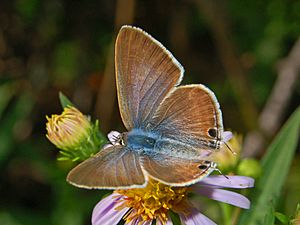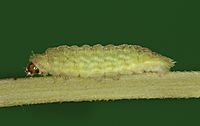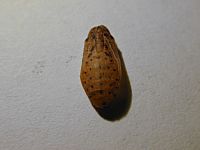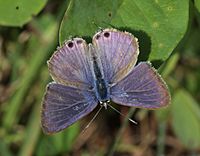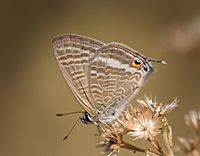Pea blue facts for kids
Quick facts for kids Long-tailed pea-blue |
|
|---|---|
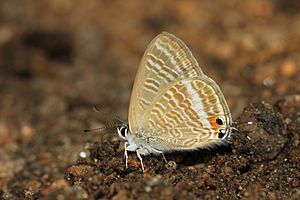 |
|
| Lampides boeticus. Underside | |
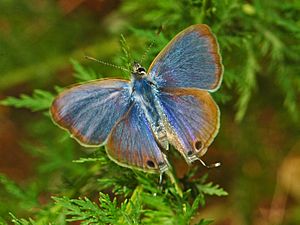 |
|
| Lampides boeticus. Male. Upperside | |
| Conservation status | |
| Scientific classification | |
| Kingdom: | |
| Phylum: | |
| Class: | |
| Order: | |
| Family: | |
| Genus: |
Lampides
|
| Species: |
L. boeticus
|
| Binomial name | |
| Lampides boeticus (Linnaeus, 1767)
|
|
| Synonyms | |
|
List
Papilio boeticus Linnaeus, 1767
Papilio damoetes Fabricius, 1775 Lycaena leguminis Scott, 1890 (unavailable syn) Papilio coluteae Fuessly, 1775 Papilio archias Cramer, [1777] Papilio pisorum Fourcroy, 1785 Papilio boetica Fabricius, 1793 Lampides armeniensis Gerhard, 1882 Polyommatus bagus Distant, 1886 Lampides grisescens Tutt, [1907] Lampides caerulea Tutt, [1907] Lampides caeruleafasciata Tutt, [1907] Lampides clara Tutt, [1907] Lampides clarafasciata Tutt, [1907] Lampides coerulea Tutt, [1907] Lampides ab. fasciata Tutt, [1907] Lampides fusca Tutt, [1907] Lampides ab. fuscafasciata Tutt, [1907] Lampides typicamarginata Tutt, [1907] Lampides ab. major Tutt, [1907] Lampides minor Tutt, [1907] Lampides typicafasciata Tutt, [1907] Lampides ab. albovittata Oberthür, 1910 Lampides ab. ecaudata Oberthür, 1910 Polyommatus yanagawensis Hori, 1923 Lampides obsoleta Evans, [1925] Lampides fusca de Sagarra, 1926 Lycaena ab. minor Pionneau, 1928 Lampides infuscata Querci, 1932 Lampides ab. kawachensis Hirose, 1933 Lampides anamariae Gómez Bustillo, 1973 Lampides boeticus f. michaeli Kroon, 1980 |
|
The Long-tailed Pea-Blue (Lampides boeticus) is a beautiful small butterfly. It's part of the gossamer-winged butterfly family, known for its delicate wings. You might also hear it called the Pea Blue.
Contents
What's in a Name?
The scientific name boeticus comes from Baetica. This was a Roman province located in what is now Spain.
The common name "Long-tailed Pea-Blue" tells you a lot about this butterfly.
- "Long-tailed" refers to the thin, long tails on its back wings.
- "Blue" describes the bright, shiny blue color of the male butterflies.
- "Pea" comes from the fact that pea plants are a favorite food for the butterfly's caterpillars.
Where Do They Live?
You can find the Long-tailed Pea-Blue in many parts of the world. They live in Europe, Africa, South Asia, Southeast Asia, and Australia.
Their Home
These butterflies like to live in places that are warm and sunny. They can be found at the edges of forests, in mountain meadows, and in flowery areas. They can even live high up in the mountains, sometimes as high as 2,700 metres (8,900 ft) above sea level.
What Do They Look Like?
The Long-tailed Pea-Blue is a small butterfly. Its wingspan is about 24 to 32 millimeters for males and 24 to 34 millimeters for females. This means their wings stretch about the length of a few small coins.
Male vs. Female Butterflies
Male and female Long-tailed Pea-Blues look a bit different. This is called sexual dimorphism.
- Males usually have bright, shiny violet-blue wings on top. The edges of their wings are brown.
- Females have less blue color. They only have a small amount of blue in the center of their wings.
Both male and female butterflies have a thin, long tail on each of their back wings. They also have two black spots near the tails on their back wings.
Wing Patterns
The underside of their wings is a yellowish-brown color. It has white patterns and a larger white stripe near the outer edge. Each back wing has two small black "eye-spots" next to the tails. These spots also have orange marks around them.
It's easy to mix up this butterfly with others like Leptotes pirithous or Cacyreus marshalli. However, the Long-tailed Pea-Blue is usually bigger than these other species.
Life Cycle
The Long-tailed Pea-Blue can have up to three generations in a single year. Adult butterflies fly from February all the way to early November. They are also strong travelers and can migrate long distances.
Eggs
The eggs of this butterfly are white with a hint of green. They are shaped like a disc and are about 0.5 millimeters wide. The female butterfly lays each egg by itself on the flower buds of its favorite plants.
Caterpillars
When they are older, the caterpillars can be green or reddish-brown. They have a dark stripe down their back. These caterpillars grow to be about 14 to 15 millimeters long.
Pupae
The pupae (the stage before becoming an adult butterfly) are about 9 to 10 millimeters long. They are light grayish-brown with some dark spots and a dark stripe on their back.
What They Eat
The caterpillars of the Long-tailed Pea-Blue love to eat flowers, seeds, and pods. They mostly feed on plants from the Fabaceae family, which includes many types of beans and peas. Some of their favorite plants are Medicago, Crotalaria, Polygala, Sutherlandia, Dolichos, Cytisus, Spartium, and Lathyrus species. They have also been seen eating Crotolaria pallida.
Ant Friends
In Australia, sometimes ants from the Froggattella, Iridomyrmex, or Camponotus groups will look after the caterpillars.
See also
 In Spanish: Canela estriada para niños
In Spanish: Canela estriada para niños



